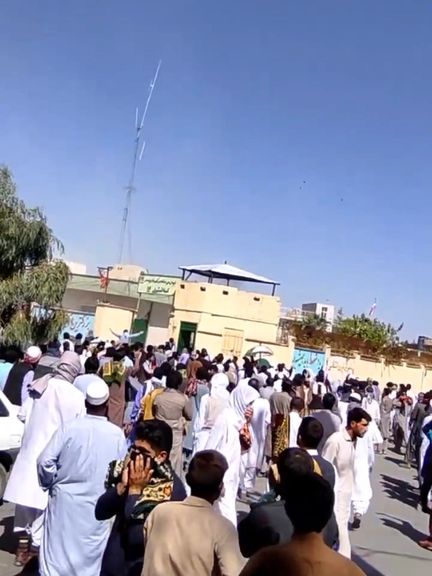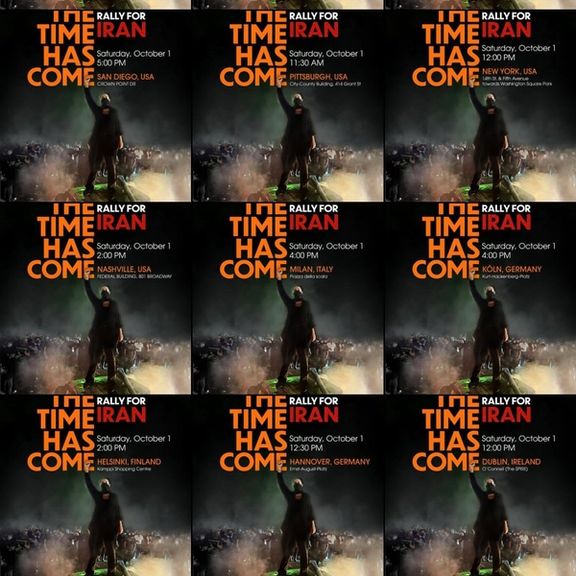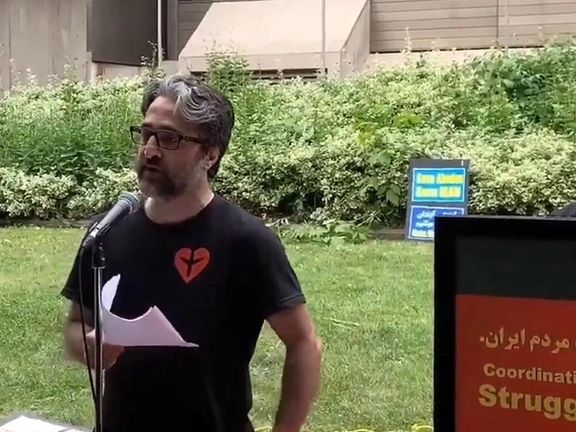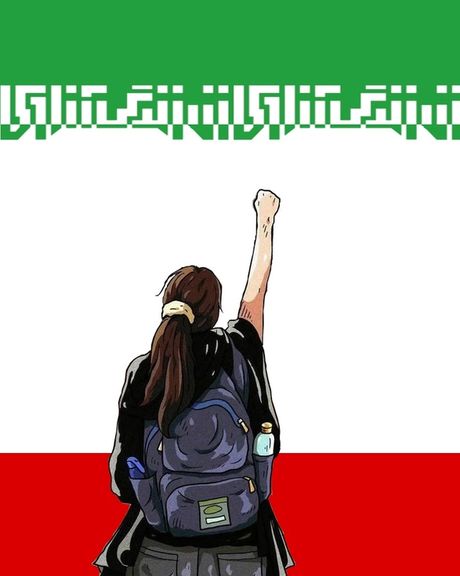Several Killed As Police Shoots Protesters In Southeastern Iran

Reports coming from the mainly Sunni city of Zahedan in southeastern Iran say at least 19 people were killed on Friday as police opened fire at protesters.

Reports coming from the mainly Sunni city of Zahedan in southeastern Iran say at least 19 people were killed on Friday as police opened fire at protesters.
Videos obtained by Iran International showed security forces violently cracking down on the protests in the city.
Gunshots are heard in videos as protesters congregate outside a police station. Local sources say that angry protesters have managed to take control of a police station. In the videos, choppers are also seen flying over the protesters in the city.
The government says protesters tried to storm three police station, but that cannot be verified from videos published on social media.
The official IRNA news agency has confirmed 19 deaths, but unofficial sources cite higher figures.
Molavi Abdolhamid, the religious leader of Iran’s largely Sunni Baluch population living in the province and Iran's top Sunni cleric, has called on the Law Enforcement forces to crack down on protesters.
The Sunni cleric in Iran, sometimes critical of the government, confirmed reports last Friday about the rape of a 15-year-old girl in June by Colonel Ebrahim Khouchakzai, the commander of the police in the city of Chabahar.
That incident and the current protests in other cities triggered the tensions in Zahedan on Friday.

A group of seminary students and teachers have said that Supreme Leader Ali Khamenei's ‘Guardianship’ is no longer valid considering the numerous atrocities and crimes committed under his rule.
According to a statement released to media on Friday, by some members of seminaries in Qom, Mashhad and Tehran, Khamenei is not considered a ‘mujtahid’, using an Islamic legal term which means he does not have the required expertise in the Arabic language, theology, revealed texts, and principles of Sharia jurisprudence. They added that he cannot be a "source of emulation" or "religious reference".
"As people who have spent their lives studying religion, we firmly and with full knowledge state that in this so-called Islamic government, none of the influential officials and authorities are mujtahids,” read the statement, which bears no name of signatories.
Using Islamic or jurisprudential argumentation, they said his rule is illegitimate due to his numerous documented crimes and faults.
They added that a letter was sent to the seminaries by the office of Khamenei in the city of Qom, led by his son Mojtaba, warning the senior clerics not to express support for the ongoing protests.
There are reports that Khamenei has also forced the seminaries to give his son, reportedly being groomed to succeed his father as Supreme Leader,the title of “Ayatollah,” an honorific title for high-ranking Shia clergy.
In a speech to military commanders on September 21, Khamenei did not mention ongoing proteststhat can pose a serious challenge to his rule.

After two weeks of protests and uprising in Iran, the country's media and politicians are beginning to know one of the key players fighting for change.
Iran's Generation Z is a generation like no other. The country's ruthless security forces realized this as soon as they set foot in the streets that have been turned into battlefields. They seem to be the first generation of Iranians who not only stand face to face with the security forces, but they also fight back after every attack.
They do not mind hitting and kicking policemen and militia that shoot at them often at point blank range. And they have no respect whatsoever, for the teachings and favorite lifestyle of the Islamic Republic and its clerics. They want one thing: Change; most notably a regime change.
In an article on the conservative news website Nameh News, the website's editor Mosrtafa Sadeghi wrote that "The Iranian government can neither completely suppress this new generation, nor it can ignore them." Sadeghi noted that ignoring the Generation Z will only lead to their radicalization.
He is probably right. It was the first time after 43 years that Iran's security forces in Qom were attacked by Molotov Cocktails.
According to Sadeghi those who are carrying out the ongoing uprising are neither like the working class that revolted in 2017, nor like the Middle Class that mourned for the victims of the downing of a Ukrainian airliner in 2020. They are a new generation that has baffled politicians and security forces alike. Sadeghi further said: "They are neither left nor right winger. They are rebels. They are the children of social media who have staged a rebellion against the country's decision-makers and traditional media they no longer trust. Instead, they turn to foreign-based media."
"They follow a different lifestyle, spend time at cafes and take long walks with friends while discussing cultural issues. At the same time, they want to know why so many restrictions have been imposed on them," Sadeghi wrote. The ruling clerics wish to dictate their own lifestyle upon them, but they won't take it.
Like Sadeghi, Mahmoud Vaezi, the former Chief of Staff of ex-President Hassan Rouhani, suggests that "the government should try to understand this new generation and listen to their demands." He said in an interview on Thursday, that what is happening these days in Iran is far more violent than the protests in 2019, when security forces killed at least 1,500 protesters. But like hardliner officials of the current government, Vaezi warned that no one should be allowed to take advantage of the protests and destroy public property.
In a symbolic gesture that reveals a bit of what the new generation is looking for, a video on social media show children at a school in Tehran replacing the picture of Ayatollah Ruhollah Khomeini, the founder of the Islamic Republic with a poster carrying one of the main slogans of the uprising in Iran: "Women, Life, Freedom."
Since the early 1980s, the Islamic Republic has violently suppressed all resistance against its dictatorship, never apologized for its mistakes, and has never been accountable for its crimes against humanity and violation of human rights, but this new generation, the Generation Z, has shown at least during the past two weeks, that it is posing a tough challenge that the Islamic Republic might find difficult or even impossible to tackle

Residents in the southwestern city of Ahvaz, which had been relatively quiet during the past two weeks compared to other Iranian cities, held protest rallies on Friday.
According to videos posted on social media, security forces have used teargas to disperse the gatherings in Ahvaz, the capital city of the oil-rich Khuzestan province.
In the videos, women are seen removing their headscarves and swinging them in the air as a symbol of their protest to the compulsory hijab or dress code rules as well the death of Mahsa Amini, the girl whose was mortally wounded in the hands of the country’s so-called morality police, which hassparked an uprising in the country.
Late in May and into the following months, many cities across the province were scenes of angry protests over price rises and economic deprivation triggered by the deadly collapse of a building in the city of Abadan. The gatherings to mourn victims who died in the collapse soon turned intoanti-government protests, with people chanting slogans popular at other antigovernment protests including “Clerics Must Get Lost”, “Our enemy Is Here, It’s a Lie To Say It’s America”, and “Neither Gaza, Nor Lebanon”.
The protests were followed in several other cities and towns across the country and took the Islamic Republic security apparatus one month to repress them.

People in Iran and abroad have planned worldwide protests on Saturday against the Islamic Republic after two weeks of rallies sparked by the death of Mahsa Amini.
Spearheaded by Hamed Esmaeilion, the Canada-based spokesman for the families of victims of Ukrainian flight PS752, shot down by Iran in January 2020, the worldwide protests are scheduled to be held in many capitals of the world as well as many other cities. Demonstrators will congregate outside the Islamic Republic’s embassies on Saturday, October 1.

Iranians have never experienced such unanimity and unity for a common goal, which seems to be the collapse of the regime in Tehran. This time the protests in Iran are not limited to a specific geographic location or a social group such as teachers, retirees or the urban poor.
Since the death of the 22-year-old Mahsa Amini in custody of the hijab – or so-called morality police -- daily protests in Iran have continued while the authorities keep threatening the people and increasing repression against protesters and celebrities.

Revolution in the Fall
Late-September is when students go back to classes in Iran, but this fall they are on strike and going out to streets. Hundreds of university professors have also announced they would not hold classes unless all their detained students are freed. Prisons are getting more crowded every day as authorities arrest more protesters.
In a video posted on Twitter Wednesday, a truck driver said some drivers have been on strike for three days but have not been able to inform others of their call to strike due to internet disruptions by the government. On Thursday, the coordination council of oil industry workers issued a statement saying they would go on strike if suppression of protesters and arrests continue.
The officials, who only refer to the protests as “riots” and blame “foreign enemies”, claim that ‘rioters’ are back in their homes, and all is quiet now after they arrested some of the “leaders of the riots” and threatened to take action against celebrities many of whom have published posts on social media supporting the protesters’ cause and condemning violence against them.
The head of the country’s police said in a statement this week that the security forces will keep defending the Islamic Republic “until the last moment,” which implies that they are envisioning their last moment of resistance against the popular protests.
However, some things are different about the current wave of protests that the regime does not seem to be able to outmaneuver with the same propaganda and crackdown tactics it has used before.
Protesters, especially Generation Z, are hopeful that they can change the regime. Their voices have never been heard like this before. The Persian hashtag in support of the protests following the death of Mahsa Amini has been retweeted over 150 million times, and still counting, a feat that is far beyond the capabilities of a single country or a solo mindset. The entire world has helped in achieving this number and now the world seems to be watching and awaiting the result.

Global support
More and more international figures including politicians, celebrities, artists, literati and intellectuals have been voicing their support for the Iranian protests. European leaders and politicians are talking about joint punitive measures against Tehran; US Democrats and Republicans have found common ground in their support for Iranian people; Beliebers (Justin Bieber fans) and rock fans joined the chorus; Slovenian philosopher Slavoj Žižek and American thinker Noam Chomsky are of the same opinion that the women in Iran have inspired the world; and different hacktivist groups are also backing the revolution in cybersphere.
Even different Iranian opposition groups -- from supporters of the exiled opposition group Mujahedin-e Khalq Organization (MEK) to the admirers of Iran’s exiled royal family, from Kurdish groups to secular democrats – are supporting the Iranian peoples’ cause this time.
Several US officials, including the White House Security Advisor Jake Sullivan, have admitted that the last time Iranians rose up against the regime following the rigged election in 2009 – the so-called Green Movement – Washington was not prepared for support but now they want to be ready for change and have their contingencies in place.
Since 2009, almost everything has become worse for Iranians, such as inflation, brain-drain and personal freedoms. Iranians do not see any hope in the future of the Islamic regime, and are hopeful for a better future in a country not at war with the free world.

A bipartisan resolution at the US Senate has called on Iran to end its violent crackdown against peaceful protestors following the death of 22-year-old Mahsa Amini.
Senators Chris Coons (D-Del.) -- the co-chair of the Senate Human Rights Caucus -- and James Lankford (R-Okla.) introduced the resolution on Thursday condemning the death of the Iranian woman, whose killing earlier in Sptember by Iran’s “morality police” sparked nationwide protests. The resolution urges the Islamic Republic to end its “systemic persecution of women."
“This resolution sends a clear message that the United States stands behind the rights of women and peaceful protesters in Iran and reaffirms that our commitment to human rights, women’s rights, and democratic freedoms is core to our values and foreign policy,” Coons said.
Senior members of the Senate Foreign Relations Committee have also voiced support for the popular protests in Iran.
Senator Bob Menendez (D-NJ), who is the chairman Senate Foreign Relations Committee, said on Thursday that Iranian protesters should know that people in the US and everywhere in the world see and praise their courage against the violent, oppressive and misogynistic regime of Iran, expressing hope to see a free Iran that is in peace with its neighbors and people.
Jim Risch (R-Idaho) ranking member of the Senate Foreign Relations Committee, said the protests indicate Iranians’ desire for a free and peaceful country, adding that the Biden administration's blind pursuit of a new nuclear deal will only empower the regime.